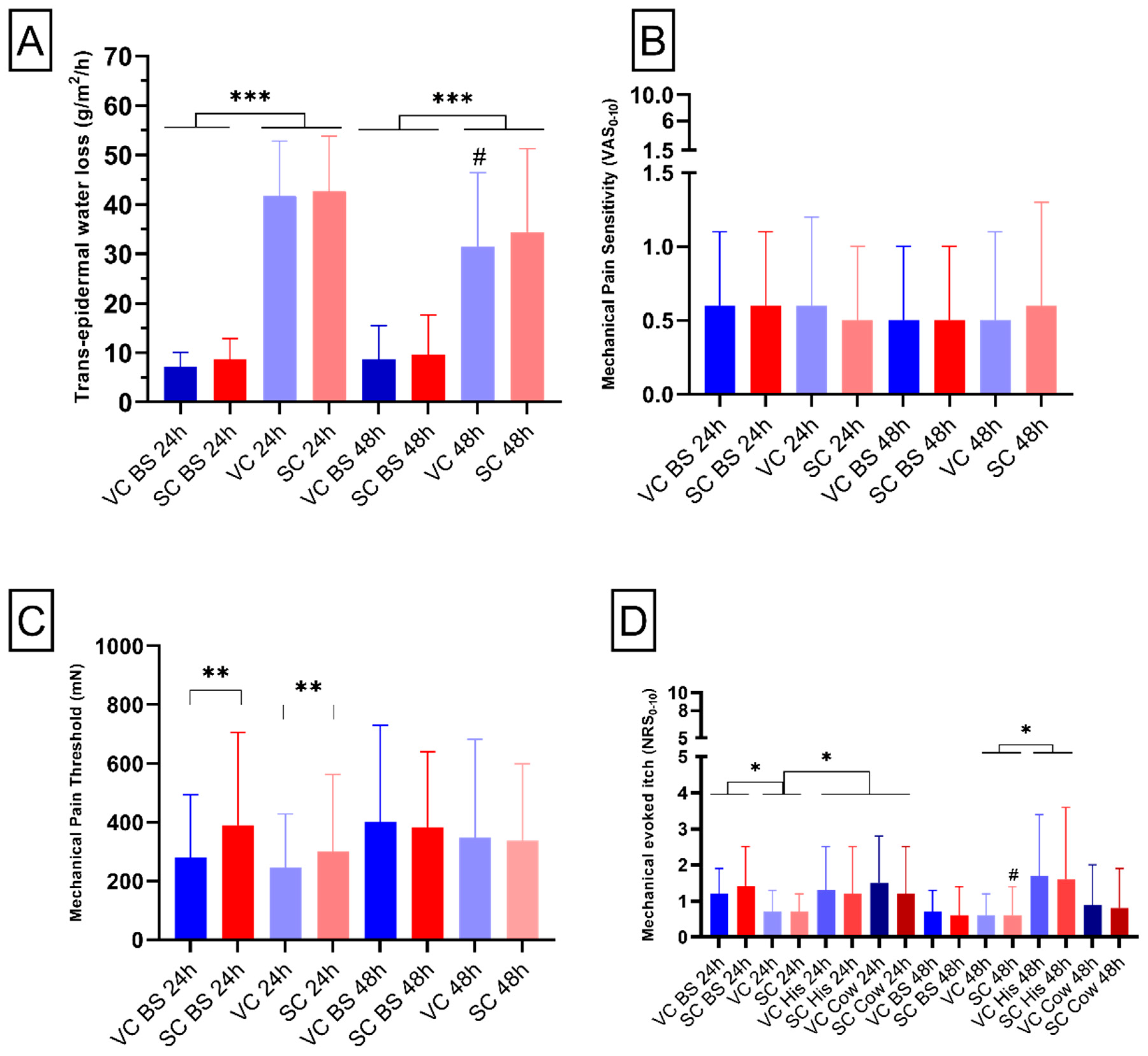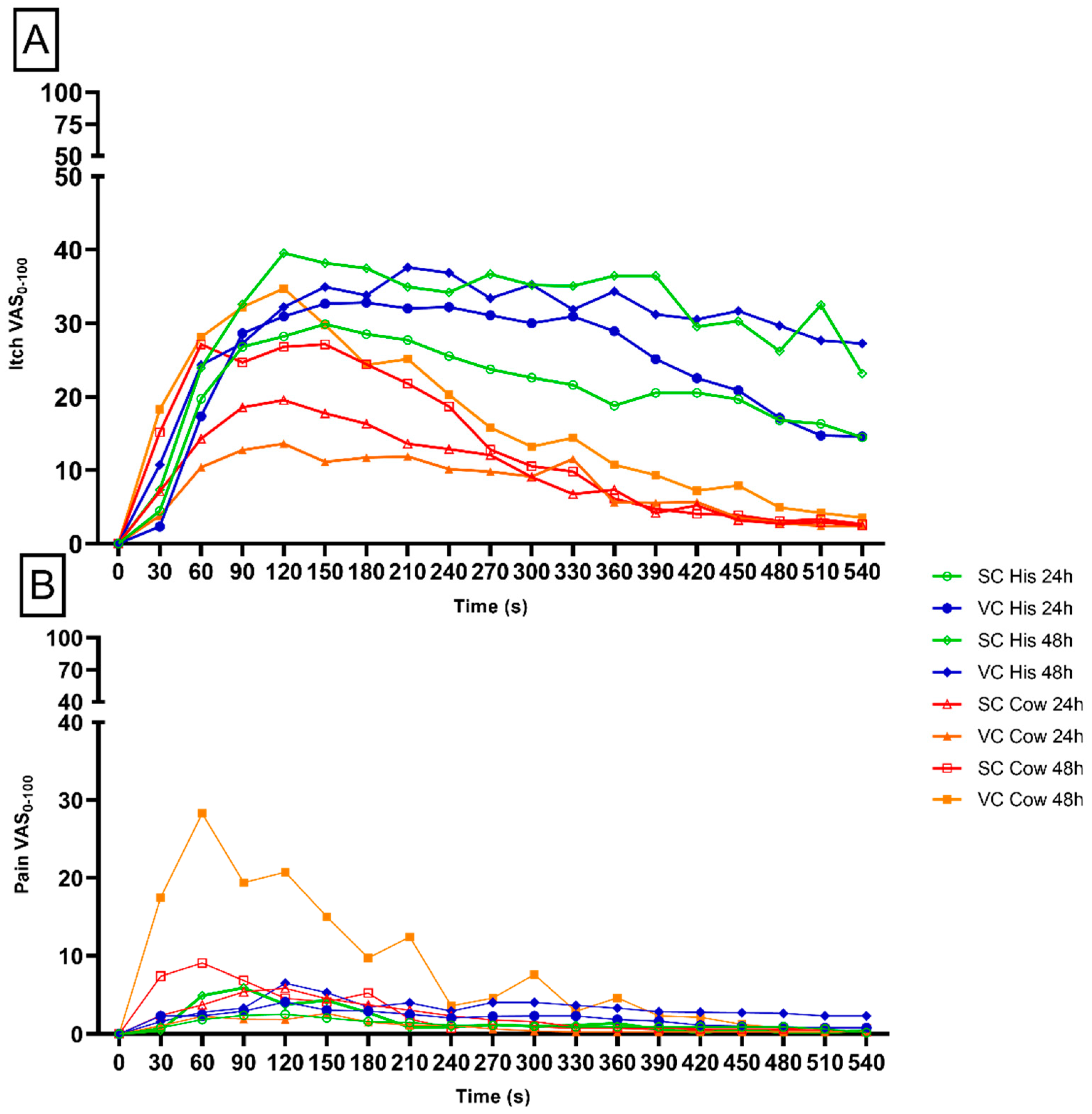Effects of Salicornia-Based Skin Cream Application on Healthy Humans’ Experimental Model of Pain and Itching
Abstract
:1. Introduction
2. Results
2.1. Demographics for Evaluated Cohort
2.2. Trans-Epidermal Water Loss for Assessments of Skin Irritation and Tissue Permeability
2.3. Mechanical Pain Assessments
2.4. Mechanically Evoked Itch
2.5. Thermal Assessments
2.6. Pruritonergic Itching and Pain Intensities
3. Discussion
4. Materials and Methods
4.1. Study Design and Cohort
4.2. Extraction of Salicornia Ramosissima
4.3. Cream Composition, Itch, and Pain Induction Parameters
4.3.1. Microvascular Reactivity
4.3.2. Evaluation of Skin Permeability
4.3.3. Measurement of Mechanically Evoked Itch
4.3.4. Measurement of Mechanical Pain Thresholds (MPT) and Mechanical Pain Sensitivity (MPS)
4.3.5. Thermal Sensitivity
4.3.6. Assessment of Itching and Pain Intensities
4.3.7. Statistical Analysis
5. Conclusions
Author Contributions
Funding
Institutional Review Board Statement
Informed Consent Statement
Data Availability Statement
Acknowledgments
Conflicts of Interest
References
- Giordano, R.; Saii, Z.; Fredsgaard, M.; Hulkko, L.S.S.; Poulsen, T.B.G.; Thomsen, M.E.; Henneberg, N.; Zucolotto, S.M.; Arendt-Nielsen, L.; Papenbrock, J.; et al. Pharmacological Insights into Halophyte Bioactive Extract Action on Anti-Inflammatory, Pain Relief and Antibiotics-Type Mechanisms. Molecules 2021, 26, 3140. [Google Scholar] [CrossRef] [PubMed]
- Silva, H.; Caldeira, G.; Freitas, H. Salicornia Ramosissima Population Dynamics and Tolerance of Salinity. Ecol. Res. 2007, 22, 125–134. [Google Scholar] [CrossRef] [Green Version]
- Jefferies, R.L.; Gottlieb, L.D. Genetic Differentiation of the Microspecies Salicornia Europaea L. (Sensu Stricto) and S. Ramosissima, J. Woods. New Phytol. 1982, 92, 123–129. [Google Scholar] [CrossRef]
- Lima, A.R.; Castañeda-Loaiza, V.; Salazar, M.; Nunes, C.; Quintas, C.; Gama, F.; Pestana, M.; Correia, P.J.; Santos, T.; Varela, J.; et al. Influence of Cultivation Salinity in the Nutritional Composition, Antioxidant Capacity and Microbial Quality of Salicornia Ramosissima Commercially Produced in Soilless Systems. Food Chem. 2020, 333, 127525. [Google Scholar] [CrossRef]
- Surget, G.; Stiger-Pouvreau, V.; Le Lann, K.; Kervarec, N.; Couteau, C.; Coiffard, L.J.M.; Gaillard, F.; Cahier, K.; Guérard, F.; Poupart, N. Structural Elucidation, in Vitro Antioxidant and Photoprotective Capacities of a Purified Polyphenolic-Enriched Fraction from a Saltmarsh Plant. J. Photochem. Photobiol. B Biol. 2015, 143, 52–60. [Google Scholar] [CrossRef]
- Isca, V.M.S.; Seca, A.M.L.; Pinto, D.C.G.A.; Silva, H.; Silva, A.M.S. Lipophilic Profile of the Edible Halophyte Salicornia Ramosissima. Food Chem. 2014, 165, 330–336. [Google Scholar] [CrossRef] [Green Version]
- Piirainen, M. Pattern of Morphological Variation of Salicornia in North Europe. Nord. J. Bot. 2015, 33, 733–746. [Google Scholar] [CrossRef]
- Kim, J.; Karthivashan, G.; Kweon, M.H.; Kim, D.H.; Choi, D.K. The Ameliorative Effects of the Ethyl Acetate Extract of Salicornia Europaea L. And Its Bioactive Candidate, Irilin B, on LPS-Induced Microglial Inflammation and MPTP-Intoxicated PD-Like Mouse Model. Oxidative Med. Cell. Longev. 2019, 2019. [Google Scholar] [CrossRef] [Green Version]
- Lee, J.M.; Yim, M.J.; Choi, G.; Lee, M.S.; Park, Y.G.; Lee, D.S. Antioxidant and Anti-Inflammatory Activity of Six Halophytes in Korea. Nat. Prod. Sci. 2018, 24, 40–46. [Google Scholar] [CrossRef] [Green Version]
- Tabassum, N.; Hamdani, M. Plants Used to Treat Skin Diseases. Pharmacogn. Rev. 2014, 8, 52–60. [Google Scholar] [CrossRef] [Green Version]
- Lautié, E.; Russo, O.; Ducrot, P.; Boutin, J.A. Unraveling Plant Natural Chemical Diversity for Drug Discovery Purposes. Front. Pharmacol. 2020, 11, 397. [Google Scholar] [CrossRef]
- Doi, N.; Togari, H.; Minagi, K.; Nakaoji, K.; Hamada, K.; Tatsuka, M. Protective Effects of Salicornia Europaea on UVB-Induced Misoriented Cell Divisions in Skin Epithelium. Cosmetics 2020, 7, 44. [Google Scholar] [CrossRef]
- Honari, G.; Maibach, H. Skin Structure and Function. Appl. Dermatotoxic. 2014, 1–10. [Google Scholar] [CrossRef]
- Rolke, R.; Baron, R.; Maier, C.; Tölle, T.R.; Treede, R.D.; Beyer, A.; Binder, A.; Birbaumer, N.; Birklein, F.; Bötefür, I.C.; et al. Quantitative Sensory Testing in the German Research Network on Neuropathic Pain (DFNS): Standardized Protocol and Reference Values. Pain 2006, 123, 231–243. [Google Scholar] [CrossRef]
- Backonja, M.M.; Attal, N.; Baron, R.; Bouhassira, D.; Drangholt, M.; Dyck, P.J.; Edwards, R.R.; Freeman, R.; Gracely, R.; Haanpaa, M.H.; et al. Value of Quantitative Sensory Testing in Neurological and Pain Disorders: NeuPSIG Consensus. Pain 2013, 154, 1807–1819. [Google Scholar] [CrossRef] [PubMed]
- Holm, H.; Akiyama, T.; Ann, L.; Laarhoven, A. van Alloknesis and Hyperknesis—Mechanisms, Assessment Methodology, and Clinical Implications of Itch Sensitization. Pain 2018, 159, 1185–1197. [Google Scholar]
- Schmelz, M.; Petersen, L.J. Neurogenic Inflammation in Human and Rodent Skin. News Physiol. Sci. 2001, 16, 33–37. [Google Scholar] [CrossRef] [Green Version]
- Mørch, C.D.; Gazerani, P.; Nielsen, T.A.; Arendt-Nielsen, L. The UVB Cutaneous Inflammatory Pain Model: A Reproducibility Study in Healthy Volunteers. Int. J. Physiol. Pathophysiol. Pharmacol. 2013, 5, 203. [Google Scholar]
- Kelchen, M.N.; Menon, G.; Ten Eyck, P.; Prettypaul, D.; Brogden, N.K. A Pilot Study to Evaluate the Effects of Topically Applied Cosmetic Creams on Epidermal Responses. Ski. Pharmacol. Physiol. 2018, 31, 269–282. [Google Scholar] [CrossRef]
- Leung, D.Y.M.; Boguniewicz, M. Atopic Dermatitis and Allergic Contact Dermatitis. Middlet. Allergy Essent. First Ed. 2017, 265–300. [Google Scholar] [CrossRef]
- Akdeniz, M.; Gabriel, S.; Lichterfeld-Kottner, A.; Blume-Peytavi, U.; Kottner, J. Transepidermal Water Loss in Healthy Adults: A Systematic Review and Meta-Analysis Update. Br. J. Dermatol. 2018, 179, 1049–1055. [Google Scholar] [CrossRef] [PubMed]
- Granger, C.; Brown, A.; Aladren, S.; Narda, M. Night Cream Containing Melatonin, Carnosine and Helichrysum Italicum Extract Helps Reduce Skin Reactivity and Signs of Photodamage: Ex Vivo and Clinical Studies. Dermatol. Ther. 2020, 10, 1315–1329. [Google Scholar] [CrossRef]
- Lünnemann, L.; Ludriksone, L.; Schario, M.; Sawatzky, S.; Stroux, A.; Blume-Peytavi, U.; Garcia Bartels, N. Noninvasive Monitoring of Plant-Based Formulations on Skin Barrier Properties in Infants with Dry Skin and Risk for Atopic Dermatitis. Int. J. Women’s Dermatol. 2018, 4, 95–101. [Google Scholar] [CrossRef] [PubMed]
- Lumpkin, E.A.; Caterina, M.J. Mechanisms of Sensory Transduction in the Skin. Nature 2007, 445, 858–865. [Google Scholar] [CrossRef] [PubMed]
- Caterina, M.J.; Julius, D. The Vanilloid Receptor: A Molecular Gateway to the Pain Pathway. Annu. Rev. Neurosci. 2003, 24, 487–517. [Google Scholar] [CrossRef] [PubMed] [Green Version]
- Bagood, M.D.; Isseroff, R.R. TRPV1: Role in Skin and Skin Diseases and Potential Target for Improving Wound Healing. Int. J. Mol. Sci. 2021, 22, 6135. [Google Scholar] [CrossRef]
- Fukuoka, M.; Miyachi, Y.; Ikoma, A. Mechanically Evoked Itch in Humans. Pain 2013, 154, 897–904. [Google Scholar] [CrossRef] [Green Version]
- LaMotte, R.H. Allodynia and Alloknesis. Encycl. Pain 2013, 87–90. Available online: https://link.springer.com/referenceworkentry/10.1007%2F978-3-540-29805-2_154 (accessed on 26 January 2021).
- Ikoma, A.; Steinhoff, M.; Ständer, S.; Yosipovitch, G.; Schmelz, M. The Neurobiology of Itch. Nat. Rev. Neurosci. 2006, 7, 535–547. [Google Scholar] [CrossRef]
- Wahlgren, C.F.; Hagermark, O.; Bergstrom, R. Patients’ Perception of Itch Induced by Histamine, Compound 48/80 and Wool Fibres in Atopic Dermatitis. Acta Dermato-Venereol. 1991, 71, 488–494. [Google Scholar] [CrossRef]
- Imamachi, N.; Goon, H.P.; Lee, H.; Anderson, D.J.; Simon, M.I.; Basbaum, A.I.; Han, S.K. TRPV1-Expressing Primary Afferents Generate Behavioral Responses to Pruritogens via Multiple Mechanisms. Proc. Natl. Acad. Sci. USA 2009, 106, 11330. [Google Scholar] [CrossRef] [Green Version]
- Andersen, H.H.; Elberling, J.; Arendt-Nielsen, L. Human Surrogate Models of Histaminergic and Non-Histaminergic Itch. Acta Derm.-Venereol. 2015, 95, 771–779. [Google Scholar] [CrossRef] [PubMed] [Green Version]
- Steinhoff, M.; Ständer, S.; Seeliger, S.; Ansel, J.C.; Schmelz, M.; Luger, T. Modern Aspects of Cutaneous Neurogenic Inflammation. Arch. Dermatol. 2003, 139, 1479–1488. [Google Scholar] [CrossRef] [PubMed]
- LaMotte, R.H.; Shimada, S.G.; Green, B.G.; Zelterman, D. Pruritic and Nociceptive Sensations and Dysesthesias from a Spicule of Cowhage. J. Neurophysiol. 2009, 101, 1430. [Google Scholar] [CrossRef] [PubMed] [Green Version]
- Sikand, P.; Shimada, S.G.; Green, B.G.; LaMotte, R.H. Similar Itch and Nociceptive Sensations Evoked by Punctate Cutaneous Application of Capsaicin, Histamine and Cowhage. Pain 2009, 144, 66. [Google Scholar] [CrossRef] [Green Version]
- Papoiu, A.D.P.; Tey, H.L.; Coghill, R.C.; Wang, H.; Yosipovitch, G. Cowhage-Induced Itch as an Experimental Model for Pruritus. A Comparative Study with Histamine-Induced Itch. PLoS ONE 2011, 6, e17786. [Google Scholar] [CrossRef]





| Demographics | |
|---|---|
| Participants (n) | 30 |
| Female (%) | 15 (50%) |
| Male (%) | 15 (50%) |
| Age (mean ± SD) | 25.1 ± 2.46 |
Publisher’s Note: MDPI stays neutral with regard to jurisdictional claims in published maps and institutional affiliations. |
© 2022 by the authors. Licensee MDPI, Basel, Switzerland. This article is an open access article distributed under the terms and conditions of the Creative Commons Attribution (CC BY) license (https://creativecommons.org/licenses/by/4.0/).
Share and Cite
Giordano, R.; Aliotta, G.E.; Johannesen, A.S.; Voetmann-Jensen, D.; Laustsen, F.H.; Andersen, L.A.; Rezai, A.; Fredsgaard, M.; Vecchio, S.L.; Arendt-Nielsen, L.; et al. Effects of Salicornia-Based Skin Cream Application on Healthy Humans’ Experimental Model of Pain and Itching. Pharmaceuticals 2022, 15, 150. https://doi.org/10.3390/ph15020150
Giordano R, Aliotta GE, Johannesen AS, Voetmann-Jensen D, Laustsen FH, Andersen LA, Rezai A, Fredsgaard M, Vecchio SL, Arendt-Nielsen L, et al. Effects of Salicornia-Based Skin Cream Application on Healthy Humans’ Experimental Model of Pain and Itching. Pharmaceuticals. 2022; 15(2):150. https://doi.org/10.3390/ph15020150
Chicago/Turabian StyleGiordano, Rocco, Giulia Erica Aliotta, Anja Stokholm Johannesen, Dina Voetmann-Jensen, Frederikke Hillebrand Laustsen, Lasse Allermann Andersen, Aman Rezai, Malthe Fredsgaard, Silvia Lo Vecchio, Lars Arendt-Nielsen, and et al. 2022. "Effects of Salicornia-Based Skin Cream Application on Healthy Humans’ Experimental Model of Pain and Itching" Pharmaceuticals 15, no. 2: 150. https://doi.org/10.3390/ph15020150
APA StyleGiordano, R., Aliotta, G. E., Johannesen, A. S., Voetmann-Jensen, D., Laustsen, F. H., Andersen, L. A., Rezai, A., Fredsgaard, M., Vecchio, S. L., Arendt-Nielsen, L., Thomsen, M. H., & Stensballe, A. (2022). Effects of Salicornia-Based Skin Cream Application on Healthy Humans’ Experimental Model of Pain and Itching. Pharmaceuticals, 15(2), 150. https://doi.org/10.3390/ph15020150








